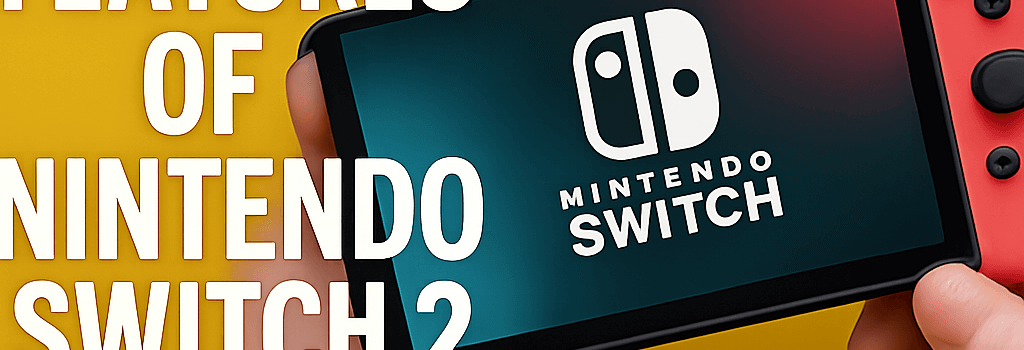11 Hidden Features of Nintendo Switch 2 You Didn’t Know

With the official launch of the Nintendo Switch 2 just days away, gaming journalists have only had limited early access to hardware and firmware. At a private daylong preview event, we unpacked system-level settings, hardware quirks, and the new AI-powered GameChat—finding features that go far beyond gaming. Here are 11 capabilities you may not know your Switch 2 can do, along with deeper technical insights and expert commentary.
1. AI-Powered Live Captioning in GameChat
The Switch 2’s new GameChat uses on-device machine learning to transcribe up to four simultaneous voices in real time, displaying captions beside your gameplay window. Under the hood, Nintendo utilizes a custom NPU inside the Tegra X3 SoC, running a low-latency speech-to-text model refined for conversational gaming audio.
“We optimized the acoustic model to achieve sub-100 ms latency and under 10% word-error rate in typical living-room environments,” says Dr. Hana Fujimoto, senior audio engineer at Nintendo. The captions can be resized or repositioned, giving hard-of-hearing players and streamers a seamless experience.
2. Text-to-Speech Messaging for Silent Play
Flipping the caption feature on its head, GameChat also lets you type messages on the virtual keyboard and have them spoken back to your party via a built-in text-to-speech engine. The engine runs on the same NPU cluster, using a lightweight neural vocoder. Though the voice is slightly robotic, it’s intelligible enough to relay coordinates, strategy tips, or quick status updates without unmuting your microphone.
3. Advanced Head-Tracking Camera Module
Attach the new 1080p USB-C camera accessory and activate head-tracking mode. It uses an IR depth sensor and computer-vision algorithms to crop and center your face within a circular frame, updating at 30 fps. This is ideal for streamers or local multiplayer sessions in Mario Kart World, though fast head turns can produce a 100–150 ms sync delay.
4. Precision Kickstand Angle Detection
A surprising mini-game in the Switch 2 Welcome Tour uses a hidden IMU embedded in the tablet chassis to measure kickstand angle within ±2°. The system fuses data from a 3-axis accelerometer and gyroscope over I2C, confirming the tilt after 2–3 seconds of stillness. While not suited for tilt-controlled games, it’s proof Nintendo is packing hardware sensors into everyday components.
5. Mouse Cursor Mode for System Menus
Passing your finger over a tiny optical sensor on the Joy-Con’s edge activates a system-wide mouse pointer. The pointer can navigate menus, click buttons, and even support double-click zoom. Under the hood, the sensor is a modified low-power optical flow module—similar to those in mini-drones—sampling at 250 Hz to ensure smooth cursor movement.
6. Adjustable Pointer Sensitivity Levels
You can choose from Low, Medium, or High sensitivity in Settings ▶ System ▶ Mouse Mode. At high sensitivity, a 1 cm hand shift maps to full-screen movement, while low sensitivity offers millimeter-scale precision—handy in the Welcome Tour’s electric-maze mini-game.
7. Find Lost Controllers via HD Rumble 2
Misplaced Joy-Cons? In Settings ▶ Controllers ▶ Find Controllers, select a paired Joy-Con or Pro Controller 2 to emit a distinctive ringtone through its new HD Rumble 2 motor. The haptic driver now supports frequency-modulated vibrations up to 500 Hz, making the beep both audible and easy to localize—even under couch cushions.
8. Secure Boot and System-Wide PIN Lock
The Switch 2’s bootloader integrates a TrustZone-backed Secure Boot, ensuring only Nintendo-signed firmware runs at startup. You can also set a 4-digit PIN, required after standby or power-on. This hardware-rooted security prevents unauthorized access, ideal for families and protecting user profiles.
9. Battery Charge Limiter to Extend Lifespan
In Settings ▶ Battery ▶ Charge Limit, you can cap charging at 90% capacity. The system’s BMS (Battery Management System) uses a Ricoh power controller (model RPxxxx) and implements adaptive CC-CV algorithms to reduce stress on LiPo cells, prolonging cycle life by up to 20% over the device’s lifetime.
10. Dynamic Text Resizing and High-Contrast UI
Nintendo upgraded its custom UI framework—built on a stripped-down Qt derivative—to allow text scaling from 80% to 200%. You can also toggle bold and high-contrast modes, improving legibility in bright outdoor environments or for vision-impaired players.
11. System-Level A/B Button Swap
For players accustomed to Xbox and PlayStation controllers, you can swap A and B for confirm/cancel actions across all system menus (Settings ▶ Controls ▶ Button Mapping). The remapping occurs at the OS input driver layer, ensuring consistency in both docked and handheld modes.
Deep Dive: Future Firmware Roadmap and Homebrew Potential
Nintendo has hinted at quarterly firmware updates adding new social features, USB-C audio enhancements, and improved party hosting. While the Secure Boot chain currently blocks unsigned code, some data-mining experts predict an exploit in Tegra’s early boot ROM could open the door to a modest homebrew scene—albeit one Nintendo will patch aggressively.
Developer Implications of New System Features
Third-party developers can leverage the Switch 2’s NPU and camera APIs to create in-game accessibility overlays or customized voice chat solutions. Nintendo’s SDK now includes middleware for caption rendering and text-to-speech, opening opportunities for indie studios focusing on inclusive design.
Best Practices for Maximizing Battery Health
To get the most cycles out of your Switch 2 battery, keep the charge limit at 90%, avoid extreme temperatures, and use the official 65 W USB-C PD adapter. According to Dr. Marco Liù, a battery chemist at Panasonic, “Maintaining charge between 20% and 80% significantly slows down capacity fade in 3.7 V LiPo cells.”